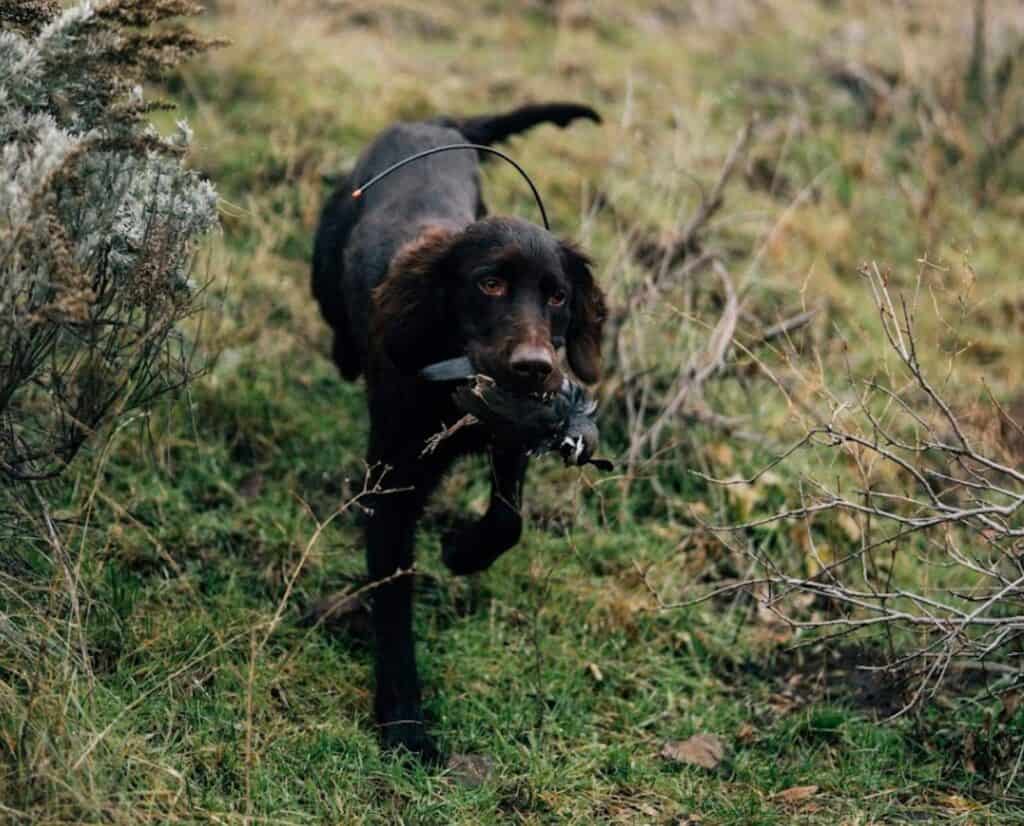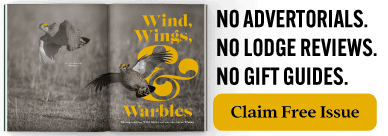Home » Hunting Dogs » German Longhaired Pointer (Deutsch Langhaar) Breed Profile
German Longhaired Pointer (Deutsch Langhaar) Breed Profile

Jennifer Wapenski is the Director of Operations and Managing Partner…
A versatile pointing breed with a strong emphasis on tracking and game recovery
Despite being relatively unknown in North America outside of niche groups, the German Longhaired Pointer (GLP) is actually the oldest of the German pointing dog breeds. In North America, the breed is divided between lines that retain their German registry (and strict breeding regulations) and those that do not. To avoid confusion between the two, the German-language name Deutsch Langhaar (DL) is used to denote dogs that are registered in Germany.
The breed is prized for its excellent hunting ability, strong nose, and especially for its work after the shot to recover downed birds or wounded big game.
History
Like many of the long-haired pointing dogs, the GLP traces its history loosely through the early 1800s with influences from regional types of hunting dogs along with foreign dogs that likely included setters and épagneuls. It wasn’t until 1879 that breeders agreed upon what the national, long-haired pointing dog should look like; the official breed standard was established in 1897.
The official English translation of the breed standard offers the following historical remarks:
“The German long-haired Pointing Dog combines the bloodlines of a bird-, hawk- and water dog as well as of Bracken (Scenthounds). He therefore has scope for great versatility. Since 1879 pure breeding has been carried out the main characteristics of the breed. In 1897, Baron von Schorlemer wrote the first standard for the German Long-haired and thus laid the foundation stone for today’s pure breeding.”
The standard has been refined over time, but the most notable change was in 1908 when the color black was officially disallowed (having been a point of disagreement between clubs prior to then). From that point on, only brown, brown-and-white, and various shades of brown roan were allowed. German Longhaired Pointers with black in their coats went on to form the Large Munsterlander breed instead.
GLPs And DLs In Germany
In Germany, the breed is often known as the Alter Försterhund, or Old Forester’s Dog. A Forester is a professional who is responsible for maintaining a particular piece of land and managing all aspects of the local ecology, including the wildlife population. Hunting is seen as a critical part of agricultural and silvicultural management, and foresters often set hunting harvest targets to maintain appropriate balance on the land. Historically, this also involved protection from poachers who sought to steal game resources from the land.
A forester’s dog, then, had to be a Jack-of-all-trades who could reliably find target game, recover wounded animals, work well in the water, dispatch predators, and stand up to a nefarious human threat. This requires a dog with a tough mentality and a level of intelligence that allows it to work independently in the field but also maintain a strong connection with their handler.
Today, the breed is popular among hunters and modern-day foresters in Germany. They rely on the dogs’ intelligence and strong working drive. The Deutsch Langhaar Verband is the governing organization for the breed in Germany, with member chapters that cover smaller regions within Germany as well as a member chapter in North America.
In some European countries, such as the Netherlands and Denmark, the breed has become a bit lighter and faster to suit the field trial sports. This can be attributed to changes in the local hunting opportunities and new demographics which do not always need or want the breed’s strength or sharpness.

Hunting Style
German Longhaired Pointers are very strong pointers, especially for versatile hunting dogs which need to balance prey drive with the patience needed to point. They are exceptionally good at tracking, often hunting with a nose-down style in search of ground scent. They will naturally relocate on a running bird and often need a fair amount of experience to learn safe distances from which to point a bird without disturbing it.
Range
Their range and speed varies depending on the terrain in which they are hunting. That said, they average out to a medium range when compared to other pointing dogs. Forest work such as grouse hunting usually sees a range of about 40-50 yards, while the open prairie would typically see 150 yards or more—if the dog is experienced in hunting that type of terrain. On the other hand, they are expected to conduct independent forest searches when boar hunting in Germany. This requires them to work independently and well out of sight of the handler even in thick cover.
Game Recovery And Tracking
German hunters place a strong emphasis on “work after the shot”, or game recovery. The German Longhaired Pointer is no exception to this priority. It has a very strong natural retrieve as well as a strong aptitude for tracking ground scent. This gives them the ability to easily track down a winged bird or to work the blood and scent trail of a wounded big game animal.
Furred Game
German Longhaired Pointers have an equal love for fur as they do for feathers. Hunters should expect them to hunt small game such as rabbits in addition to birds. They are also likely to engage with any predators they encounter such as raccoons or feral cats.
GLPs And DLs Are Versatile Dogs
The ideal home for a GLP (or DL) is an opportunist hunter who is happy to hunt a mixed bag on any given day. Specialist hunters will generally be happier with specialist dogs. However, versatile dogs are a great fit for someone who is looking to hunt upland birds, waterfowl, rabbits, and recover big game.
Temperament
The best word to describe the German Longhaired Pointer’s temperament is “perceptive.” They are extremely intelligent dogs, which can be both a blessing and a curse. Their strong working drive gives them an intense desire to work, but their perceptive temperament means they are always looking to the handler for feedback. Heavy-handed training methods simply do not work with this breed. Instead, the handler must be a clear communicator and be able to teach the dog the desired behaviors without ambiguity.
In return for building this relationship of trust, the dog can be expected to develop an intense loyalty and willingness to please. In the absence of trust and clear communication, behavioral problems can develop. For this reason, the breed is not always a good choice for a first-time hunting dog handler. That is, unless the handler has a good network of help available to them. Most importantly, the handler needs to be willing to adjust to the dog. If things are not going according to plan, training plans should be modified.
The need for clear communication extends beyond the field and into home life, too. German Longhaired Pointers can be exceptional house dogs and family pets. That is, if their working drive is sufficiently met and expectations are made abundantly clear. Consistent boundaries and clear rules go a long way toward creating a reliable family and hunting dog. This is true of all hunting dogs. However, it is especially true of a breed that has maintained its strong working drive and a level of sharpness required for the work they were bred to perform.
Form
The German Longhaired Pointer is among the largest of the pointing breeds. It has more of an emphasis on strength than speed.
Males may range in size from 23.6” to 27.5” at the withers (60-70 cm). Females may range from 22.8” to 26” (58-66 cm). The average weight is noted as 66 lbs (30 kg).
The breed standard describes a form that supports intended function, including some subjective descriptions such as:
“Strong; muscular; low set; flowing lines. Smaller dogs must have plenty of substance, but too massive and thereby clumsy dogs are not desired.”
“Ground covering movement with good drive from hindquarters.”
“Special value is attached to good angulation.”
But the standard gets a bit more specific when it comes to the coat:
“The greatest importance is attached to correct coat. Neither excessively long nor too short hair. On back and sides of body: Hair 3 – 5 cm, close fitting. On underside of neck, on chest and belly, coat may be longer. Hair on head much shorter, but longer than on a short-haired German Pointing Dog. Topknot not desired. Hair on ears wavy and feathered. Hair on body is sleek, firm, smooth or slightly wavy, close fitting and dense with good undercoat. Well coated belly. Tail with good plume, coated to tip. Back of front legs feathered. Back of hind legs feathered, forming breeches. Below hock hair is significantly shorter. Dense short hair between toes. Too much feathering is not desired.”
Disqualifying faults—besides obvious physical abnormalities—include aggressive or overly shy dogs, insufficient bone and muscle, or head diverging from the breed type.

Deutsch Langhaar and German Longhaired Pointer Breeding Requirements
Deutsch Langhaar within the German versatile hunting dog association—including dogs that fall under the member chapter in North America—are held to performance and health requirements before they can be approved for breeding. This is where the divergence between the German Longhaired Pointer and the Deutsch Langhaar begins.
In order for a Deutsch Langhaar to be approved for breeding, he or she must:
- Pass the VJP (puppy natural ability test), including a gun sensitivity evaluation
- Pass the HZP (natural ability + land and water retrieving test)
- Pass a conformation evaluation at a breed show
- Demonstrate “loud” hunting by being either sight- or scent-loud on a hare track
- Engage with a predator
- Be free from hip dysplasia as evaluated via x-ray
- Have a temperament evaluated by performance and conformation judges as “calm” or “lively” but never nervous, shy, or aggressive
If a dog is bred outside of these requirements, those offspring and descendants can not be brought back into the system. This is how lines of “German Longhaired Pointers” are separated from those determined to be “Deutsch Langhaar.” In other words, while the breed origins are the same, it is the continued adherence to these requirements across the population that maintains the official German lines.
Outside of the German system, German Longhaired Pointers can be evaluated in NAVHDA, VHDF, AKC, and other testing systems. These tests are designed to evaluate hunting dogs. There are no standardized breeding requirements for GLPs. However, individual breeders may choose to adhere to a certain code or standard.
Finding DL and GLP Breeders
As with any hunting dog, finding a breeder that you trust is a critical part of the selection process. There are very few Deutsch Langhaar and even fewer German Longhaired Pointers born each year in North America. Current CDC limitations on importing puppies makes it considerably more difficult. Dogs six months old or younger cannot be imported into the United States.
The Deutsch Langhaar—Gruppe Nordamerika is the North American club for German-registered Deutsch Langhaar. Member breeders must agree to follow the club’s protocols and all breeding dogs are subject to the requirements listed above.
The German Longhaired Pointer Club of North America is the governing body for GLPs that are not managed within the German system. Members participate in various testing systems but are not held to a specific set of requirements.
Because the demand for German Longhaired Pointers or Deutsch Langhaar outpaces the supply, a prospective buyer should be prepared to answer plenty of questions about their hunting, lifestyle, and home environment. They will likely need to be placed on a waitlist for an available puppy, too. Breeders form a tight-knit community. They are very dedicated to ensuring that puppies are placed in hunting homes where they will thrive.
Jennifer Wapenski is the Director of Operations and Managing Partner at Project Upland Media Group. She has a lifelong passion for the outdoors, dogs, and wildlife; as an adult, she discovered that upland bird and waterfowl hunting were natural extensions of these interests. What started as initial curiosity soon escalated into a life-changing pursuit of conservation, advocacy, and education. Jennifer serves in a variety of roles such as the Breed Warden for the Deutsch Langhaar—Gruppe Nordamerika breed club and on an advisory committee for the Washington Department of Fish and Wildlife.




Great litter available right now – Cortney Shaefer in Nebraska.
A few Deutsch Langhaar pups are currently available to good hunting homes in Westchester, WI thru Troy Holweck and Hunter’s Shadow kennel. This litter was bred for high drive dogs with natural field and water ability. You can contact Troy and find out more about Deutsch Langhaars thru dl-gna.org
For more information on the breed, including the FCI breed standard, see https://www.dl-gna.org/about-dls. Do feel free to prowl the website, or find the group on facebook. Like the dogs, owners and breeders are very approachable should you wish to know more.
From the FCI standard linked on the linked page above, I would offer the following text regarding the coat. (BTW, the ‘leathers’ mentioned are the ears, it’s an oddity of translation.)
COAT
HAIR: The greatest importance is attached to correct coat, neither excessive growth nor too short hair. On back and sides of body: Hair 3 – 5 cm, close fitting. On underside of neck, on chest and belly, coat may be longer.
• Belly: Well coated.
• Leathers: Hair wavy and feathered.
• Tail: With good plume, coated to tip.
• Back of front legs: Feathered.
• Back of hind legs: Feathered, forming breeches.
• Below hock: Hair significantly shorter. Too much feathering is not desired. Dense short hair between toes.
• Head: Hair much shorter, but all the same, longer than on a shorthaired German Pointing Dog. Topknot not desired.
• On body: Hair is sleek, firm, smooth or slightly wavy, close fitting. Dense with good undercoat.